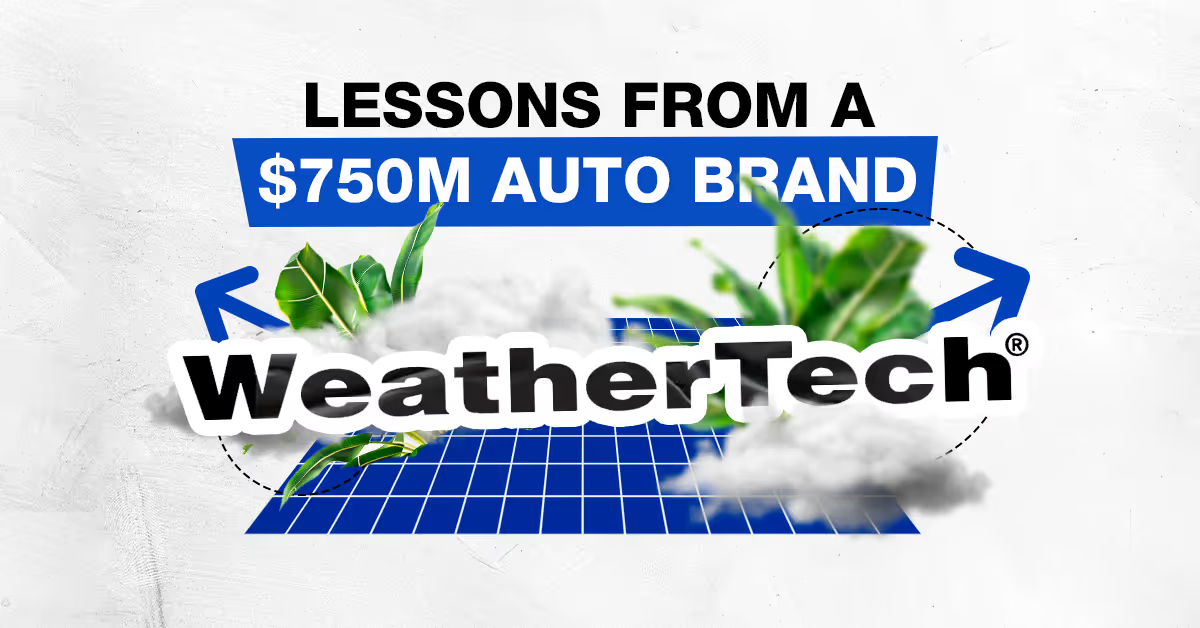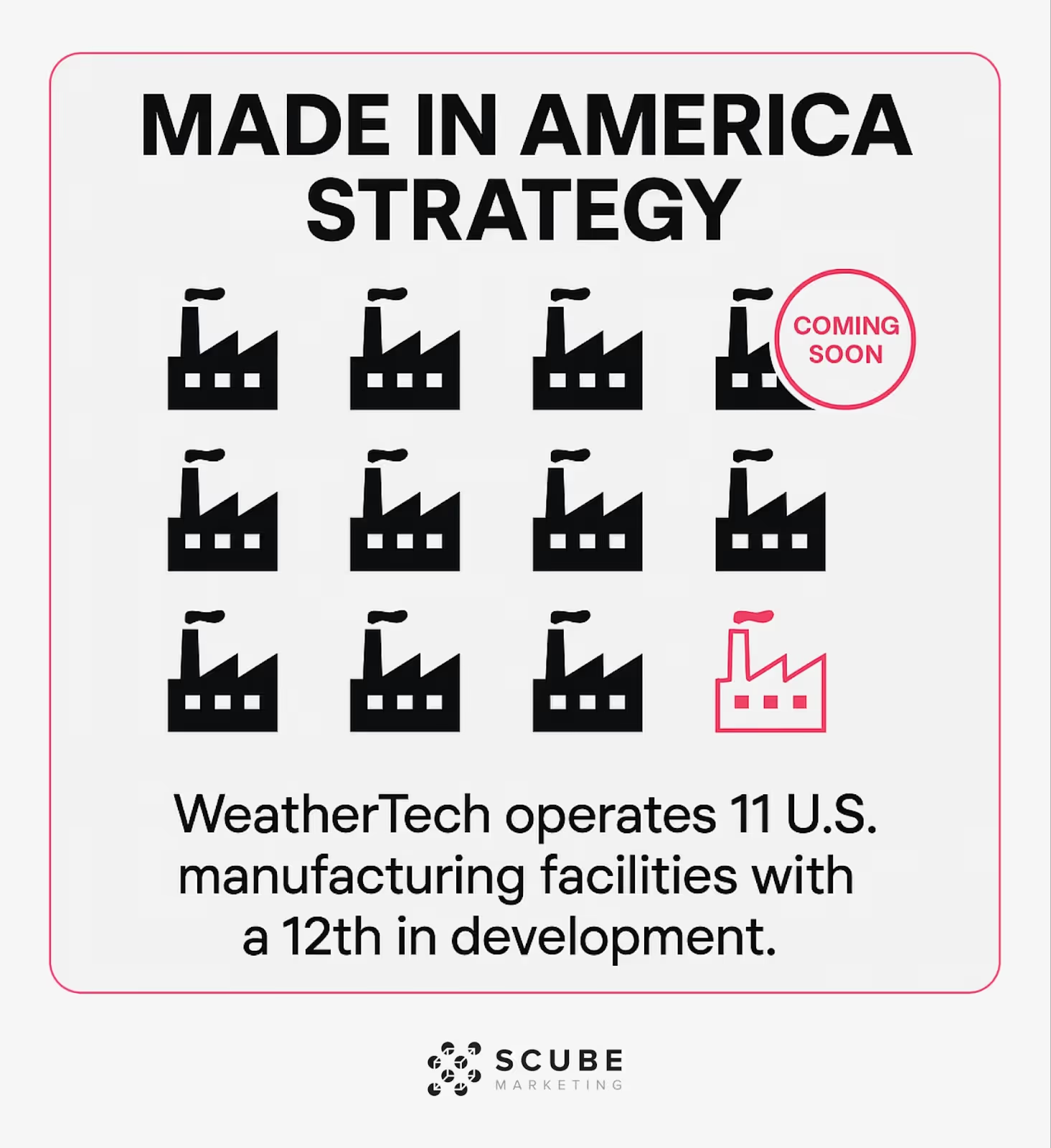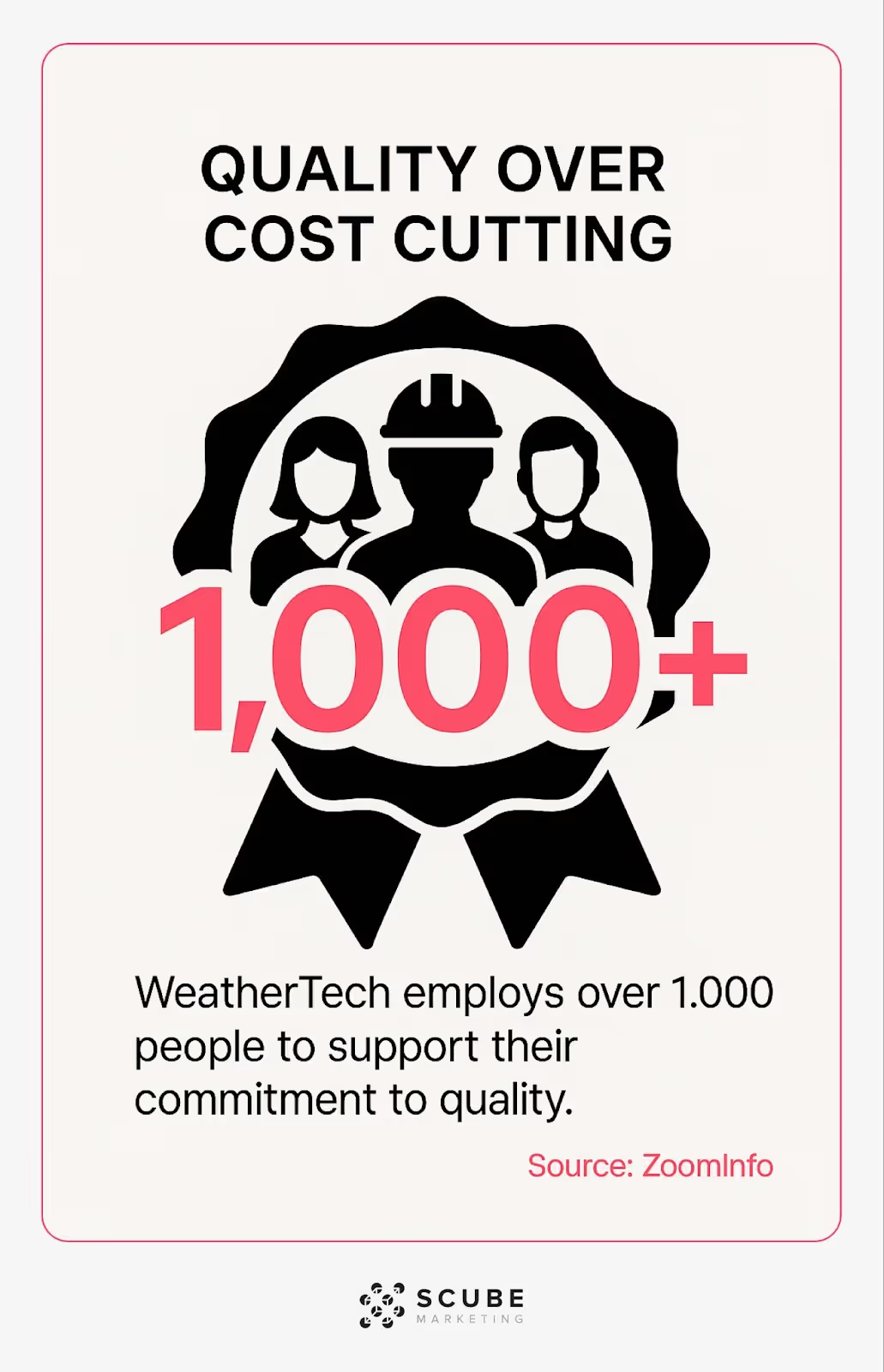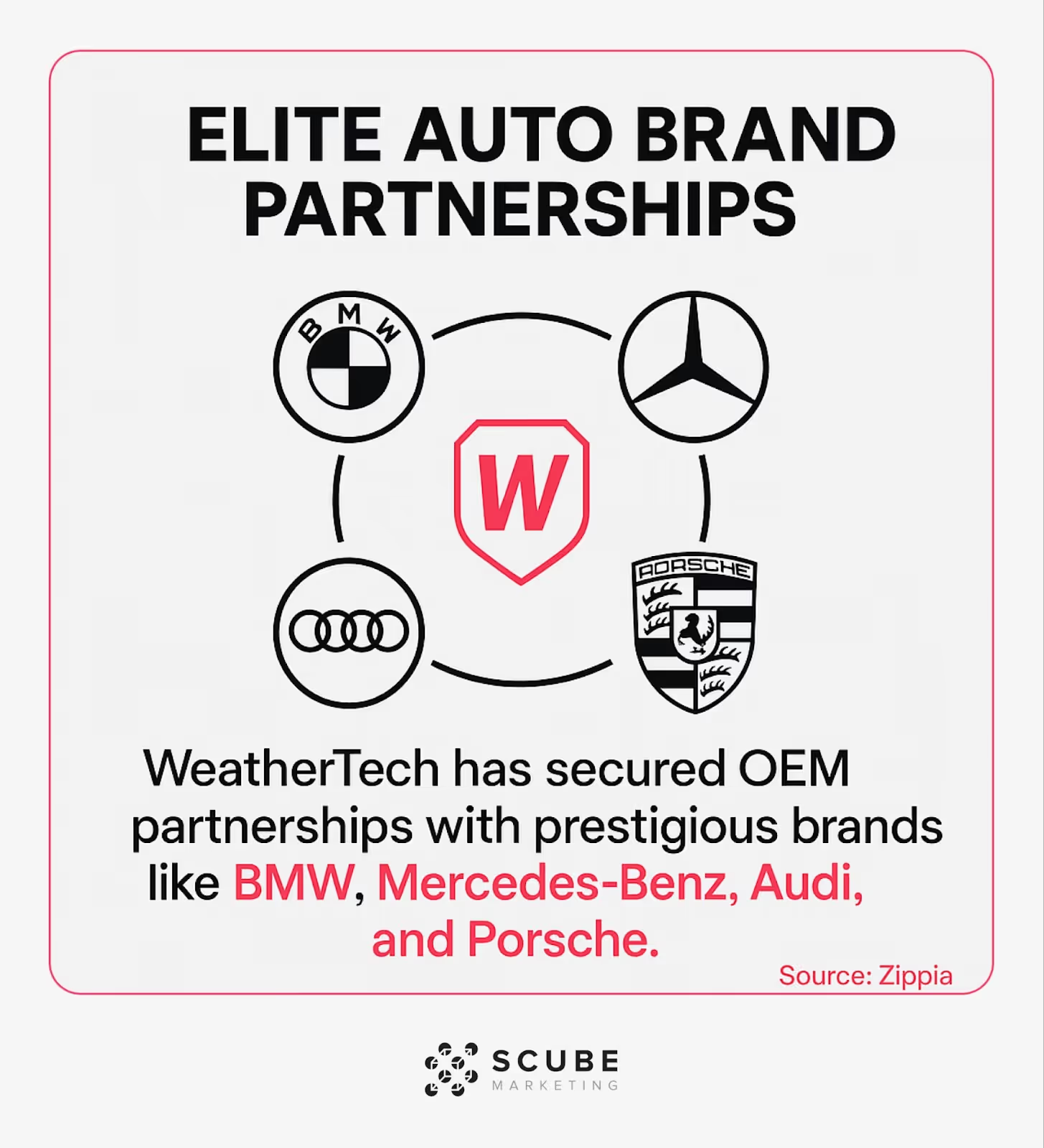
WeatherTech started from zero. Today they generate $750 million in annual revenue. (Source: LeadIQ) Their growth story contains valuable lessons for auto aftermarket founders. As a marketing agency owner working with parts retailers, I find their approach fascinating.

What makes WeatherTech different? They've rejected common industry practices. Most manufacturers outsource production overseas. Many focus solely on digital marketing tactics. WeatherTech chose another path. They built their empire through choices that challenge typical business advice.
I'll share five growth lessons from WeatherTech's playbook. You can apply these to your auto aftermarket business today. These aren't theoretical concepts. They're proven strategies with impressive results. Let's examine what makes this American success story work.
WeatherTech operates 11 U.S. manufacturing facilities with a 12th in development. (Source: LeadIQ) This level of vertical integration stands out in today's outsourcing-focused market. It gives them remarkable control over their entire production process.

This approach provides several key benefits. First, it ensures consistent quality control. When you own the manufacturing process, you don't depend on outside suppliers. Second, it creates supply chain resilience. This proved invaluable during recent global disruptions. Third, it supports their "American-made" marketing narrative.
For auto aftermarket founders, the lesson isn't to immediately build multiple factories. Instead, identify which production elements would benefit most from direct control. This might be a quality-critical component or a finishing process that sets your products apart.
Let's look at how different manufacturing approaches compare in the auto aftermarket space:
The right approach depends on your specific situation. What matters is making strategic choices about which parts of production impact your quality and brand story most.

WeatherTech employs over 1,000 people to support their commitment to quality. (Source: ZoomInfo) This investment in talent reflects their focus on premium products rather than competing on price. Their floor mats and liners aren't the cheapest options. Yet customers willingly pay more for perceived quality.
In the automotive aftermarket, price competition can be tempting. Many founders believe lower prices will win market share. WeatherTech proves the opposite can work. Their quality-focused positioning creates sustainable advantages and better margins.
What makes their approach effective is how they make quality tangible. They don't just claim their products are better. They show it through material specifications, warranty programs, and extreme testing demonstrations. Quality becomes visible to customers.
For aftermarket founders, the key is identifying your quality differentiators. Make them central to your marketing message. This only works when quality is built into your entire business, not just mentioned in ads.
Here's how WeatherTech makes their quality positioning concrete:
This consistent quality messaging trains customers to associate the brand with premium performance. The result? Higher margins and stronger customer loyalty. Customers become resistant to competitor offers based on price alone.

WeatherTech has secured OEM partnerships with prestigious brands like BMW, Mercedes-Benz, Audi, and Porsche. (Source: Zippia) These relationships provide powerful third-party validation. When luxury automakers trust your products, consumers notice.
For auto aftermarket businesses, OEM partnerships can dramatically accelerate credibility building. You benefit from the established brand's reputation. Customers view your products differently when they know an automaker has vetted them.
What's smart about WeatherTech's approach is their balance. They leverage OEM relationships without becoming dependent on them. They maintain strong direct-to-consumer channels alongside their OEM business. This creates stability and preserves margins.
Even a single strategic OEM relationship can transform an aftermarket brand's position. The benefits extend far beyond the immediate sales through that channel. The credibility transfers to all your marketing efforts.
Let's examine the specific advantages these partnerships provide:
For aftermarket founders, pursuing these relationships requires meeting high standards. The investment in quality systems and processes pays off through these valuable partnerships. Consider which OEMs align with your product quality and brand positioning.
WeatherTech's online performance shows their commitment to e-commerce excellence. They generate $13.55 million monthly revenue from 80,763 transactions and 2.28 million website sessions. (Source: Grips Intelligence) Their 3.5-4.0% conversion rate and $150-$175 average order value demonstrate sophisticated online operations.
These metrics outperform industry averages significantly. Most auto parts retailers struggle to achieve half these numbers. The difference comes from WeatherTech's systematic approach to optimization based on customer data.
Their conversion rate deserves special attention. The automotive accessories category typically sees 1.5-2.0% conversion rates. WeatherTech doubles this benchmark through effective site design, product presentation, and checkout optimization.
For aftermarket businesses seeking to improve online performance, tracking the right metrics drives successful e-commerce growth. You need to measure what matters most for your business model.
The most effective approach is implementing structured A/B testing programs. These systematically improve conversion elements rather than making changes based on assumptions. When you master A/B testing for your automotive business, you can achieve continuous improvement in results.
This data-driven mindset should extend beyond your website. Apply it to inventory management, marketing budget allocation, and customer service resources. Each business area benefits from disciplined analysis of performance data.
WeatherTech uses reverse-engineering technology to create precisely fitting products for specific vehicles. (Source: Rocket Reach) This technical advantage supports their long-term brand building strategy. They've focused on building authority over quick sales for more than three decades.
Many auto aftermarket companies chase short-term results. They rely on discounting and constant promotions. WeatherTech took the opposite approach. They invested in building a brand with clear values and consistent messaging. This created a foundation for sustainable growth.
Their message consistency stands out most. Their core value propositions—American manufacturing, superior materials, custom fit—haven't changed in decades. Meanwhile, competitors frequently shift their positioning based on market trends.
The lesson for aftermarket founders? Brand building requires patience and consistency. Short-term sales tactics that dilute your brand position will undermine long-term value. What does research reveal about successful automotive aftermarket branding? The strongest brands maintain consistent positioning while evolving their execution.
Let's look at how brand authority typically develops over time:
WeatherTech's success demonstrates the power of this long-term approach. Their patient brand building created significant advantages. These include reduced customer acquisition costs and built-in credibility when entering new product categories.
For your aftermarket business, establish clear brand values first. Then maintain consistency in how those values appear across all customer touchpoints. This builds mental associations that make your brand the default choice in your category.

WeatherTech's growth story offers a valuable blueprint for auto aftermarket founders. Their approach challenges common advice in today's business environment. Yet their results speak for themselves.
The five lessons we've explored form a cohesive strategy. Vertical integration, quality positioning, OEM partnerships, data-driven e-commerce, and long-term brand building work together. They create a resilient business model that withstands market fluctuations.
You don't need massive capital to apply these principles. Each can be adapted to businesses at different stages. How can you develop an e-commerce growth strategy that incorporates these lessons? Start by identifying which elements align with your strengths.
For implementation, consider these next steps:
The automotive aftermarket remains full of opportunity. By applying these WeatherTech-inspired principles, you can build a business that thrives through changing market conditions. Their success didn't happen overnight. It reflects decades of consistent execution. With similar commitment to fundamentals, your aftermarket brand can create its own success story.